CHAPTER 2
The Medium Format Advantages
IMAGE SHARPNESS
Thirty-five millimeter and medium format cameras use the same type of black-and-white and color films. Because the medium format negative or transparency is anywhere from two and a half to four times larger in area than the 24 × 36 mm frame, its sharpness is proportionately better. To look at it in another way, the medium format negative can be blown up proportionately larger (to 30 × 40 in. instead of 16 × 20 in.) while retaining equal quality, assuming everything else is equal.
Since the quality, especially the sharpness, of films has been improved drastically over the last few years, some people have commented that the 35 mm image quality is completely satisfactory for any application where the medium format was originally needed or suggested; that it is no longer necessary to move up to the medium format. True, 35 mm negatives can today be enlarged to greater sizes without looking grainy or fuzzy. But since the same emulsions are used for both the 35 mm and the medium format, the same quality differences still exist between 35 mm and 120 roll film. The medium format image is still better.
In my mind, it is exactly the fabulous sharpness of today’s films that is the best reason for moving up to the medium format. Medium format photography should be more attractive to the serious photographer because only the larger medium format images can truly convey the superb sharpness that is possible on these emulsions.
You will be greatly excited about the photographic image quality of the medium format when you examine the original 2 1/4 negatives or transparencies under a 10× magnifying glass and compare them with 35 mm originals. The 35 mm images might look great, but you probably would love to see the same image two and a half times to four times larger so you can really see the details that only the medium format image can reveal to you.
Prints made from almost any size negative are salable, and 35 mm transparencies are also accepted for most purposes, but the medium format images are still preferred or requested in many fields for advertisements and editorial purposes. By presenting the larger medium format transparencies, you will have a definite edge over your 35 mm competitors with many clients and art directors. You will convey a professional image and make a good impression on clients, who will be better able to see the results and determine how the image will fit into the advertising layout or design.
Although the 35 mm format cannot approach the sharpness of the medium format enlargement, or the beauty and effectiveness of a medium format slide presentation, image sharpness and effectiveness are not necessarily the major reasons for stepping up to the medium format. Other benefits of the medium format are even more helpful and valuable.
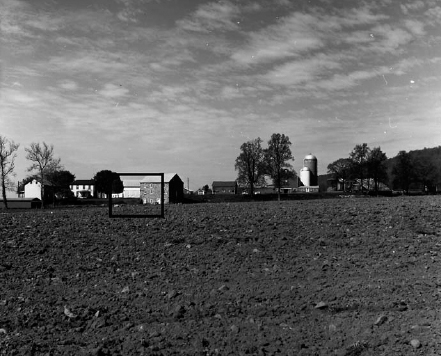
The larger medium format image can truly convey the quality of today’s high-resolution films. Note the exceptional sharpness of the white window frames, which is maintained even in the 10× blow up on the next page.
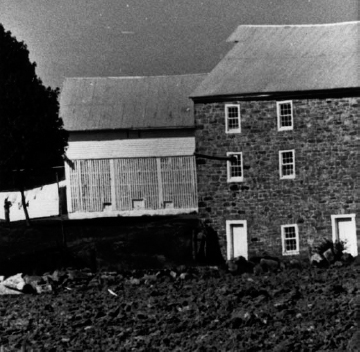
It is the edge sharpness of such lines that conveys to our eyes the impression of sharpness.
IMAGE EVALUATION
It is often said that once you work in the medium format, you’ll never go back to 35 mm, probably because the medium format negative or transparency is easier to evaluate. For example, when a 35 mm and a medium format negative or transparency are placed side by side over a light box, the effectiveness, even the quality, of the medium format negative can be determined more easily, usually with the naked eye. There is no need to use a magnifying glass except to determine critical sharpness. Cropping possibilities also can be determined effectively and accurately.
Medium format is also conducive to working with contact sheets, a favorite method of proof printing 35 mm and medium format negatives. Such proofsheets make it easy to compare images taken of the same subject or in the same location in order to select the best and decide on the final cropping. Differences in pose, lighting, expression, depth of field, composition, and even sharpness can be detected easily and usually without the use of a magnifying glass. The 35 mm contact proof images are frequently too small for this purpose. This is why many 35 mm photographers have the more expensive enlarged proofs made. The twelve 2 1/4 in. square or sixteen 4.5 × 6 cm images from a 120 roll film also fit well on a single sheet of 8 × 10 in. paper.
Proofsheets also provide a simple way for filing negatives. Negatives in their protective envelopes can easily be stored next to the proofsheet in a ring binder or filing cabinet.
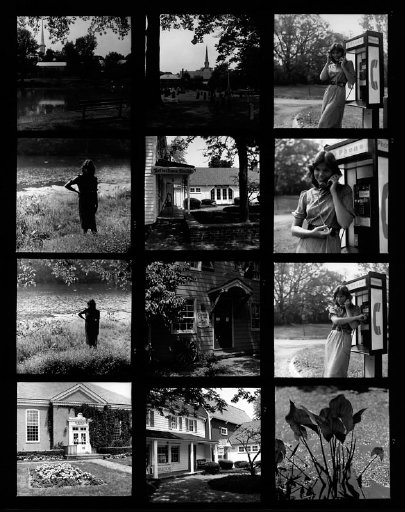
The 12 images on the 2 1/4 in. square (above) or the 16 images on a 6 × 4.5 cm proofsheet are large enough to be evaluated carefully with the naked eye. Possible changes in the image format can also be determined easily. This is more difficult or impossible with 35 mm contact proofsheets (right). A 35 mm proof-sheet also needs to be turned to see verticals and horizontals properly.

FOCUSING SCREEN
The focusing screen size must be among the medium format considerations.
On any SLR or TLR camera, the focusing screen is the size of the negative; consequently, the medium format focusing screen is anywhere from two and a half to four and a half times larger than its 35 mm counterpart. The larger screen does not necessarily provide more accurate focusing, but a more effective image evaluation, and you may be able to do so without needing to use a magnifying viewfinder.
Standard so-called waist-level finders, which allow two-eyed image evaluation, are available for square format medium format cameras. Using a waist-level finder, you can do a complete and accurate evaluation of the image while viewing the screen with both eyes open— as you would evaluate the final print or projected transparency.
I still believe that viewing the focusing screen with both eyes open is the best way to evaluate the effectiveness of the image or decide what might be necessary to make it more effective. Viewing with both eyes gives you a different impression from what you get by looking with one eye through a prism finder. Indeed, this might be the most important step in making you a better photographer.
One reason the square camera is such a popular medium format is because such cameras are always held the same way; they never need to be turned and thus can be equipped with any type of finder, eye level or waist level.
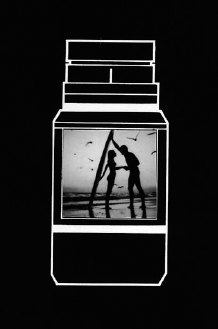
The large focusing screen of the medium format camera provides a view camera view on a compact camera and is helpful for composing and evaluating the effectiveness of the image.
CROPPING
For maximum image quality from any negative, the photographer must frame the subject or scene so that the entire negative, at least in one direction, can be used for the enlargement. A cropped negative must be enlarged more, which means there will be a decrease in the quality of the image. Cropping, however, is an important step in putting an image in its final form. Here the medium format can show its advantage and increased possibilities. Even if the photographer uses only about 30 percent of the total medium format area, the negative can still be as large as the full 24 × 36 mm area of the 35 mm frame.
A square image offers even wider possibilities. You can leave it as a square or frame it into a horizontal or vertical, or into a panoramic image. You will undoubtedly start to see different compositions and different image shapes that you probably overlooked when evaluating the image on the camera’s focusing screen. The possibility of easily changing a square into other shapes to fit a layout is also a major reason why art directors in advertising agencies often prefer or insist on receiving square images.

Even if you crop a 2 1/4 in. square negative about 70 percent, you still end up with a negative that is equal to the full size of a 35 mm frame.
FILM CHANGING
Various medium format cameras, especially SLR types, are designed with a completely removable film magazine. The film is not loaded into the camera, but into a magazine that can be attached to the camera or removed from it at any time without fogging the film. Several magazines can be pre-loaded, so changing from one roll to the next is almost instantaneous; therefore you are not likely to be loading film when the most important action is taking place. Using magazines is somewhat like carrying two or three loaded cameras, except you need only one camera and lens. You can also change from one type of film to another, from black and white to color, negative to positive, daylight to tungsten, high speed to low speed or instant, at any time. There is no need to finish the roll. Changing film can be done mid-roll without wasting a frame and without carrying more than one camera.
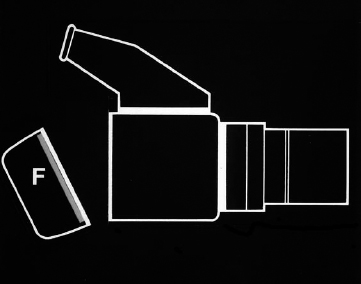
On various medium format cameras, the film is not in the camera body but in a separate film magazine, which can be removed at any time without exposing the film. Thus, film can be changed mid-roll.
Changing film mid-roll can be one of the most important advantages and a major reason for selecting the medium format. It is, next to the larger film format, the major advantage of the medium format. It places the medium format one giant step beyond 35 mm for serious photography.
Most cameras are made for roll film for 10, 12, 16, 24, or 32 images per roll depending on the format or type of film. Roll film for medium format use does not provide the 36 exposures available in 35 mm film, but roll film is available with a sufficient number of exposures to limit film changing to a reasonable level of frequency. Roll film does not need to be rewound; thus film changing can be accomplished quickly. Several medium format cameras can also take 70 mm films with about 70 exposures on a daylight loading cassette, and even more “over 100” from a darkroom spool load.
INSTANT PHOTOGRAPHY AND ELECTRONIC IMAGING
Several medium format cameras also let you attach a Polaroid magazine. All you need to do is detach the regular magazine, even in the middle of a roll, and attach the Polaroid magazine. You can then shoot one or several Polaroid shots and see the image within a minute or less.
Polaroid film shows the image exactly as you see it through the lens and confirms that everything in the camera works properly (that the flash is synchronized to the shutter, for instance). Nothing else can give you that peace of mind in important jobs. You can check exposure, lighting, and lighting contrast, which is especially valuable when you are working with multiple flash or when you are combining flash with daylight. The Polaroid image can also show things that you cannot see with your eyes or through a finder of any camera. For instance, you can see whether a certain shutter speed freezes or blurs moving subjects, and how much blur is created. You can see what a zoom shot or a camera-produced double exposure looks like or what effect a moving camera produces on the film. If you do professional work or are interested in creating images and not just recording objects as they exist, the Polaroid magazine is a great help. Other benefits of a Polaroid magazine are that you can show the client what the image will look like and get instant approval. You can also use the Polaroid shot as a teaching tool to show photography students the results of a shot instantly.
Some medium format cameras can also be equipped with a back for electronic imaging, which also allows you to see the image without the need for film processing.
SHUTTERS
Medium format cameras are in the front seat in regards to shutters, giving the serious photographer more choice between focal plane shutters, which are in the camera and move in front of the image plane, and leaf shutters, which are in the lens. There are even focal plane shutter cameras that can also be used with shutter lenses, thus offering the advantage of both types of shutters.
Focal plane shutters offer high shutter speeds going as high as 1/4000 second in the medium format. Not having to worry about a leaf shutter in the lens, the lens designer also has more freedom to play with the lens design, the focal length, the maximum aperture, and the focusing range.
With focal plane shutters, flash is synchronized only up to a certain shutter speed, and in this respect medium format types take a back seat to 35 mm cameras, some of which are synchronized with flash up to 1/250 second. The maximum shutter speed in the medium format is 1/125 second because the shutter curtain is larger and must travel farther. Some cameras only go to 1/30 second or 1/60 second, so check camera specifications closely if flash is important to you.
All leaf shutters can be used with flash up to their top speed, which is usually 1/500 second. Therefore, they are a better choice when flash synchronization at short shutter speeds is necessary or desirable, such as when photographing indoor sports or when combining flash with daylight.
Focal plane or leaf shutters can be completely mechanical or controlled electronically. Even if they function electronically, the actual opening and closing of the shutter is still a mechanical function.
CAMERA SIZE AND OPERATION
The large medium format negative or slide can be obtained with cameras that have many of the 35 mm benefits. While medium format cameras are somewhat larger and heavier, most are still lightweight and suitable for handheld photography. With most, you can also photograph as fast as with 35 mm cameras because shutter cocking and film advance is a single operation. Motor drives are available, although they do not operate as fast as 35s and do not allow you to shoot several frames per second.
The line of lenses available for medium format cameras is as extensive as for 35s. The lenses, however, tend to have somewhat smaller apertures than the 35 mm camera equivalent. Medium format cameras have become automated in many ways, especially with built-in exposure devices, and operating them is hardly more difficult than operating 35s.
Operating Automation
Medium format cameras are now available with automation in exposure and focusing that have been standard in 35 mm for some time and such features should be considered when investing in a medium format camera. Most medium format cameras have some method of metering the light in the camera, something that I consider a real benefit in most fields of photography.
At the same time, fortunately, medium format camera exposure and focus automation has not gone as far as it has on many 35 mm cameras. I purposely said fortunately because I hope that the automatic developments in the medium format will not go the 35 mm route with cameras offering a multitude of metering and focusing modes, sometimes indicated by the type of subject such as portrait, landscape, closeup, action, that might be more confusing than helpful to many photographers.
In addition, all these different exposure and focusing options need additional operating controls that must be set before you can take a picture and also need a display board so cramped with information that you can spend all your time worrying about technical details instead of concentrating on how to create an effective image. Perhaps all these different options are supposed to eliminate the need of the photographer learning something about exposure and metering.
I still feel that photographers can produce better results in a fraction of the time by learning the principles of exposure and working with a simple built-in metering system that measures the light in one specific way—often creating better pictures the old fashioned way.
